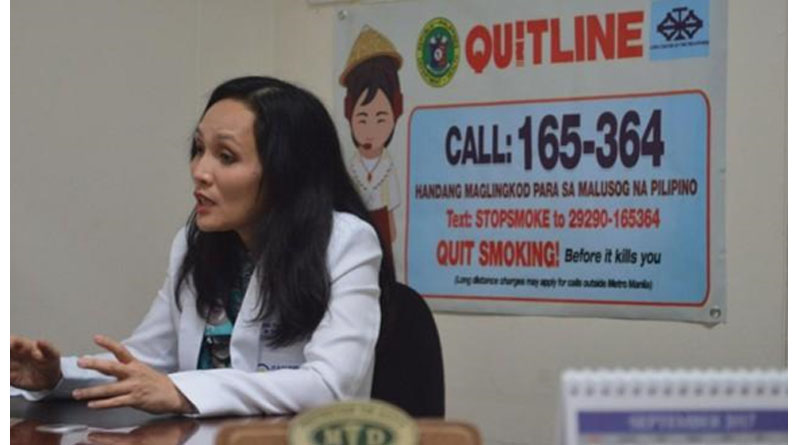Want to Quit Smoking? Remember These 7Ds

Have you ever thought of quitting your smoking habit, only to be stopped by the thought of taking just one last drag?
It’s not impossible to quit, says Lung Center of the Philippines Smoking Cessation director Dra. Glynna Ong Cabrera. However, it may take time to do so. “The cigarette has 7,000 chemicals, but the nicotine is really the one that triggers the addiction,” Cabrera tells GMA News Online in an interview. Once the nicotine goes to your brain, it activates your neurotransmitters such as dopamine that provides you pleasure—which eventually becomes your motivation to keep on smoking.

The four-step process to stopping the habit
So what should you do to quit the habit? Cabrera says you first have to have the willpower to really stop smoking. “You plan a ‘Quit Day,’” the doctor explains. Deciding on a ‘Quit Day’ varies, as only you could set it. Some people, Cabrera shares, can do it immediately, while others need enough time to let go of their habit. It doesn’t matter how you plan on doing it, the important thing is to have a target date.
Next, an intact moral support is needed in your journey to quit smoking. “Have friends who will help you in the process of stopping,” Cabrera explains. That way, you’ll have people cheering you on to reach your goal.
As for your paraphernalia such as your lighter or ashtray, it’s essential to throw them away or at least keep them out of your sight.
Lastly, you have to know your reason for wanting to quit. “Pwede kang gumawa ng emergency kit,” says Cabrera. If you’re quitting because of health reasons, put in a picture of a healthy body in the emergency kit. If it’s for your family, add a photo of them too. If it’s a money-driven issue, place the cash you would spend for your cigarettes on a daily basis in the kit and you’d be surprise how much you’ll end up saving. “Sometimes, people need reasons to do something,” the doctor says.
Coping with withdrawal symptoms
Nicotine withdrawal symptoms may include restlessness, intense cravings, and coughing—the latter caused by the natural response of your lungs as it tries to clean them from chemicals. These symptoms may make or break your journey of quitting smoking, so it’s crucial to overcome them.
To avoid going back, Cabrera says it’s important to keep in mind the 7Ds: Delay, Distract, Do something else, Drink water, Deep breathing, Divine Intervention, and the Department of Health (DOH) Quitline.
Delay is something you should do whenever you think about smoking a cigarette stick. If you feel the urge to smoke, just tell yourself “mamaya na,” until it goes away. In the process, Cabrera says, you will likely distract yourself by doing something else. That way, you’d forget that you are craving to smoke.
“Syempre, yung iba mag-cocomplain na naglalaway,” Cabrera notes. While that’s normal for someone who’s trying to quit smoking, it shouldn’t be the reason to restart the bad habit. For this, she says, drinking water helps. Complement this with deep breathing to help keep you calm.
“You have to pray for it also, for guidance,” tells Cabrera, pertaining to the needed divine intervention in the process.
But for human counseling, you may seek advice through the 24/7 DOH Quitline, launched last July, that you can contact at 165364. “Sometimes kasi, you just need to talk to somebody,” Cabrera explains. “I see smoking as the tip of the iceberg. There’s an underlying problem [as to why people smoke].” According to Cabrera, it may be triggered by a family problem or a vanity issue, but it’s something that needs to be addressed and talked about, which is why counseling is vital.
Help via the DOH Quitline
The response team of the DOH Quitline aims to have 21 counselors on a shifting schedule who will talk with smokers who want to quit 24/7. Currently, they have nine counselors helping smokers to stop ultimately.
GMA News Online was able to talk to one of the Quitline counselors, who says the idea is to have an engagement and deep conversation with the person on the other line. “As much as possible, yung rapport at pagiging comfortable nung caller ay ma-build,” says the counselor, whose identity will remain anonymous. Doing so will make it easier for people behind the hotline to help those who want to smoke.
With the DOH Quitline, you get an initial session to help you determine when to stop smoking. Then, once your Quit Day is set, the counselor will call again 24 hours before and after to check on you as you head towards smoke-free days. They will also do weekly calls to check up on you—the frequency decreasing later on, from weekly to monthly until it reaches six months.

If conversing over the phone is uncomfortable for you, you may opt for the mobile program, where you can text ‘STOPSMOKE’ to 29290-165364 to receive the quitting program on your smartphone.
“Smoke-Free Philippines is extremely delighted that the country finally has a Quitline and congratulates the Lung Center of the Philippines and the Department of Health for this very positive initiative,” says Smoke-Free Philippines, a coalition of anti-smoking advocates that aims to reduce tobacco-related diseases and deaths in the Philippines. “With the implementation of Executive Order 26 (nationwide smoking ban), more and more smokers are seeking help on how to quit smoking, hence, the Quitline is very timely and commendable.”
Resources are now widely available—but at the end of the day, Cabrera reminds smokers that it’s all about giving your full commitment in stopping the bad habit.
(Source: GMAnetwork.com)



